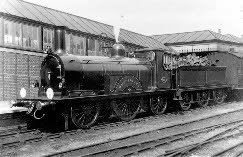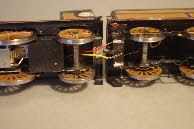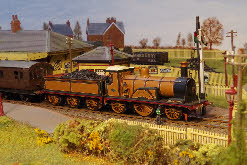



Last updated November 2019
G 2-2-2 No 323 ‘Sutherland’

 First, a couple of pictures of the real thing -
First, a couple of pictures of the real thing - ‘Sutherland’ on the left, and ‘Plumpton’ very appropriately on the right.........
Singles are never easy, and my model of ‘Sutherland’ has been no exception.
First built in 1990, it had many problems with the motor in the tender, driven via a shaft under the footplate to the 6’6” drivers. This left space for the boiler, smokebox and most of the firebox to be filled with lead. As described in an article in MRJ, the original motor was a powerful Mashima can motor, with a 50:1 worm and wheel gearbox on the drivers. The motor seemed to be prone to cogging, particularly at low speed, and with a relatively high ratio gearbox, the driving wheels slipped without the loco even getting going.
I changed the motor to an Anchoridge D11, and this improved things a bit, but it was never a great performer. The motor mount in the tender was not entirely satisfactory, and subsequently broke. It was repaired, but broke again, so the loco has been languishing, unused and unloved for the best part of ten years.
However 2016 was my ‘year of the loco’ - an attempt to finish four part-built engines, and to get the rest all in full working order. I don’t really need 24 engines for Plumpton Green, but having made them all, I should at least have them all functional.
So having failed with the tender drive, I decided to convert it to the alternative of a motor in the firebox, driving on the centre axle, with as much lead as possible in the smokebox and boiler, and a weighted tender hanging on the draw-bar to counterbalance the weight at the front of the loco.
 An hour or so’s work is all that’s required to strip down as much of the engine and tender as I need to -
An hour or so’s work is all that’s required to strip down as much of the engine and tender as I need to - no turning back! I’ve made a lot of use recently of High Level Models’ gearboxes with Mashima motors. This combination is easy to assemble, and results in a mechanism which is quiet and smooth running. Another hour’s work, and the gearbox is made, ready to fit. The HLModels gearbox of choice is the Roadrunner+ which provides a good step-down ratio, and is very flexible in terms of getting something which fits most small locos.
 My only slight problem is that in common with all my other locos, the G uses split-
My only slight problem is that in common with all my other locos, the G uses split-axle pick-up, but on the tender (for the tender drive). Trying to convert the loco chassis to split axle would be quite a task - a complete rebuild in fact. The obvious choice seems to be to retain the tender pick-up, and find a way of getting power from the tender to the loco. I’ve resolved this by soldering two small diameter tubes to the front of the tender chassis - one each side as shown - so that these are directly connected to the split frames. The connection to the the motor is very simple - very flexible wires from the motor, with a small piece of 12thou phosphor-bronze wire, bent to a tight V-shape, so that it fits tightly into the tube.
The only other modification required on the tender is to remove the centre bearing under the leading axle, and replace it with a light spring. The tender is thus supported by its two trailing axles (with side-beam compensation), and the draw bar which rests on the rear of the loco chassis. The leading axle of the tender is held down by the light spring, enough to keep the wheels on the track, but not enough to take any of the tender weight. The loco retains its fully compensated chassis - side beams on the driving and trailing axle, and centre pivot on the leading axle.
 On test it runs sweetly, quietly and smoothly, although with a tendency for the tender to derail when running in reverse. Just something else to fix!
On test it runs sweetly, quietly and smoothly, although with a tendency for the tender to derail when running in reverse. Just something else to fix!
In 2018 I carried out a full survey, measuring the axle loadings of all my locos to get a better understanding of their weight distribution, and to try to answer the question of just how heavy does a loco need to be to pull a decent length train (6ft is the maximum on Pulborough). As a result of the tests I have added little bits of lead in various places, including direct loading of the gearbox - increasing the tractive weight from 93g to a very surprising 125g. I still have to sort out the tender which I think is partly a problem with a wobbly wheel, and partly too little weight and too much sideplay on the leading axle. The G can now pull six of the balloon coaches, provided it accelerates slowly.
G 2-

 First, a couple of pictures of the real thing -
First, a couple of pictures of the real thing -Singles are never easy, and my model of ‘Sutherland’ has been no exception.
First built in 1990, it had many problems with the motor in the tender, driven via a shaft under the footplate to the 6’6” drivers. This left space for the boiler, smokebox and most of the firebox to be filled with lead. As described in an article in MRJ, the original motor was a powerful Mashima can motor, with a 50:1 worm and wheel gearbox on the drivers. The motor seemed to be prone to cogging, particularly at low speed, and with a relatively high ratio gearbox, the driving wheels slipped without the loco even getting going.
I changed the motor to an Anchoridge D11, and this improved things a bit, but it was never a great performer. The motor mount in the tender was not entirely satisfactory, and subsequently broke. It was repaired, but broke again, so the loco has been languishing, unused and unloved for the best part of ten years.
However 2016 was my ‘year of the loco’ -
So having failed with the tender drive, I decided to convert it to the alternative of a motor in the firebox, driving on the centre axle, with as much lead as possible in the smokebox and boiler, and a weighted tender hanging on the draw-
 An hour or so’s work is all that’s required to strip down as much of the engine and tender as I need to -
An hour or so’s work is all that’s required to strip down as much of the engine and tender as I need to - My only slight problem is that in common with all my other locos, the G uses split-
My only slight problem is that in common with all my other locos, the G uses split-The only other modification required on the tender is to remove the centre bearing under the leading axle, and replace it with a light spring. The tender is thus supported by its two trailing axles (with side-
 On test it runs sweetly, quietly and smoothly, although with a tendency for the tender to derail when running in reverse. Just something else to fix!
On test it runs sweetly, quietly and smoothly, although with a tendency for the tender to derail when running in reverse. Just something else to fix!In 2018 I carried out a full survey, measuring the axle loadings of all my locos to get a better understanding of their weight distribution, and to try to answer the question of just how heavy does a loco need to be to pull a decent length train (6ft is the maximum on Pulborough). As a result of the tests I have added little bits of lead in various places, including direct loading of the gearbox -